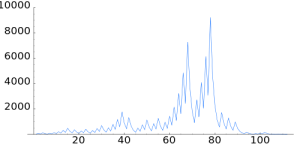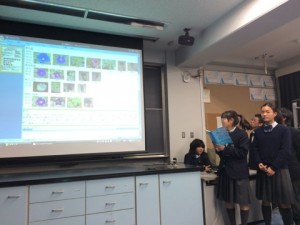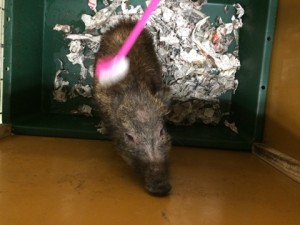- Notice
- Information for Middle and High School Researchers
- Notice of Kansai Conference
Sudden attack! Participating Schools Nearby! vol.4 Nara Prefectural Seisho Junior and Senior High School
2014.12.15
Hello!
This is Nishiyama from Libanes.
Today, I visited Nara Prefectural Seisho Junior and Senior High School!
A Study on the Roots of Japanese Peach through the Nucleus of Peach at an Archaeological Site ( Nara Prefectural Seisho High School, Biology Research Group )
We have classified the peach nuclei excavated from the Momamukai site (around the middle of the 3rd century) and the Nagara site (late 5th century) in Nara Prefecture according to their morphology. The peach nucleus from the Momamukai site dates to the Himiko period, while the Nagara site is said to be the site of the mansion of En'oji, the last ally of the Katsuragi clan. The length, width, and thickness were measured and classified based on the ratios of length/width, length/thickness, and width/thickness. As a result, it was found that there is one type of nucleus of peach nucleus at the Mumoqiang site and two types of nucleus at the Nagara site. Since the peach nucleus at the Miamukai site and the one at the Nagara site were of the same type, it is thought that the same peach was used for approximately 200 years or more. The other type of peach nucleus at the Nagara Site was excavated abruptly with Sue ware from the middle of the 5th century, suggesting that it was brought from the Korean Peninsula.
Rice Paddies Generate Electricity ( Nara Prefectural Seisho Senior High School, Science and Biotechnology Power Generation Team )
Rice (Hinohikari) was cultivated in 15L buckets filled with mud from paddy fields at three locations in Nara Prefecture. Carbon rods were placed in the buckets as electrodes, one in the mud and the other in the water. As a result, the voltage rose to 0.6V in the higher bucket, indicating that the rice and the presence of light increase the electromotive force and the rice paddy generates electricity. One typical microbial fuel cell is about 0.3V, so the voltage in this study is high. It is known that power-generating bacteria exist in the mud, and we assumed that the power-generating bacteria generated electricity. In addition, since the EMF is higher in the presence of rice and light, it is possible that the photosynthetic products are used by the power-generating bacteria. In the future, we are considering using LEDs to blink to repel wild boars in rice paddies deep in the mountains where there is no external power source.
Consider an+b analogous to the Collatz problem ( ssh course, Nara Prefectural Seisho Senior High School, 2nd year, class 4, mathematics group M2 )
The Collatz problem is "Take a positive number n, if it is odd, multiply it by 3 and add 1. If it is even, divide by 2. If you repeat this, no matter what n you choose at the beginning, at some point you will repeat 1→4→2→1". This has been verified by computer up to n quadrillion, but it has not been mathematically proven and is an unsolved problem. We will approach the Kolatz problem through numerical experiments by extending the even and odd cases of this problem (e.g., if n is divisible by 3, divide by 3; if n is divisible by 3, multiply by 4 and subtract 1; if n is divisible by 3 and there is 1 remainder, multiply by 4 and subtract 1; if there is 2 remainders, multiply by 4 and subtract 2).
The Secret of the Changing Morning Glory ( 1st Year Volunteers, Nara Prefectural Seisho Junior High School )
The wild form of the morning glory has blue round flowers and three-pointed leaves. However, in our cultivation of four varieties of morning glories, we found plants with elongated leaves like willow leaves, and plants with flowers similar to those of gentians and nadeshiko (Japanese nodding lily). From seeds of the same cultivar, two plants with three types of flowers and two types of leaves appeared in two cultivars, and three types of flowers and one type of leaf appeared in one cultivar. One plant did not form seeds and was found to have willow leaves, deeply lobed petals, no cotyledons, and a three lobed column head. Since the deeply lobed petals also had three lobes on the head, we hypothesized that the same gene was responsible for the deep lobes on the petals and the three lobes on the head. In addition, the plants with petals curled toward the front had about the same number of pores on the front and back of the leaf, suggesting that there is variation in the axes of the front and back during leaf and petal formation.
I can already feel the awesomeness of this school so far.
Two projects, Peach Nucleus and Rice Paddy Power, passed the oral presentation screening, plus the Koratz issue and the Change Morning Glory were presented as posters.
One school presented as many as four themes.
(Incidentally, there were also posters on astronomy and vegetation at the school.)
So, we will be cracking on to hear four presentations.
The first project is a peach nucleus.

It was an interesting study that unraveled the history of Japan from a scientific perspective.
But, what was regrettable was the lack of explanation of the background.
When I heard it all the way through, I thought, "I see!" but I didn't get its appeal at first.
So then there is a possibility that they will not listen to you in the first place.
That's why the advice I gave to this team was,
Everyone listening is a novice, so you have to tell a story that is easy to understand, especially at the entrance."
and that,
Present the results in a way that the audience can understand at a glance, "Here's the difference."
That is to say.
The second project is rice paddy power generation.

What is this? It may seem like "what is this?", but it is a solution to a problem that local farmers are facing.
It was a nice idea research.
I told the team here,
We must be honest about our results."
Actually, some of the data was different from what was expressed as a summary of the results.
Why such data were obtained, and what kind of experiments should be conducted to verify the causes.
I would like them to think about it.
We also advised him on the control design of the experiment, as it could use a little more work.
Now for the third Koratz issue.

by Pokipsy76
There is a problem called the Collatz Conjecture, which has yet to be proven in the mathematical community,
The first step toward solving it was to generalize the formula and search for patterns.
I am not an expert in mathematics either, but once I understood the meaning of the graphs, it was not that difficult to understand.
However, in his explanation, he did not clearly convey how to see the graphs, so I advised him to do so.
Posters should contain enough information to be understood without having to be explained."is the key point.
And last. The changing morning glory.

Here is a must-see photo of various variegated morning glories!
However, there were so many different species that I had to observe and photograph not only the petals but also the leaves, pistils, stamens, and many other parts of the flower,
We were struggling with how to present the results.
The advice given here is,"Well-arranged in a tabular format, easy to read."Technique.
Traits of different varieties are arranged with the variety name in vertical columns and traits such as petals and leaves in horizontal rows,
Or it is easier to compare traits within a variety.
Finally.
To my surprise, wild boars were being raised in the school.
They are for experimental use, and they are looking at things such as reactivity to various colors of light.

That is all! (Nishiyama)
Summary of points
(vii) Let's devise a way to show the results and make it so that people do not get confused about where to look.
(8) The results obtained are basically correct. Let's think about how we can formulate a hypothesis to explain them, and if we cannot formulate one at this point, what additional experiments we should conduct.
